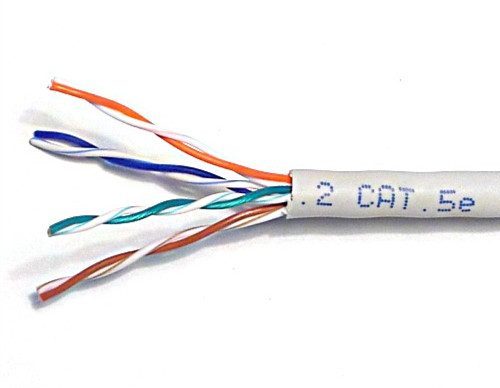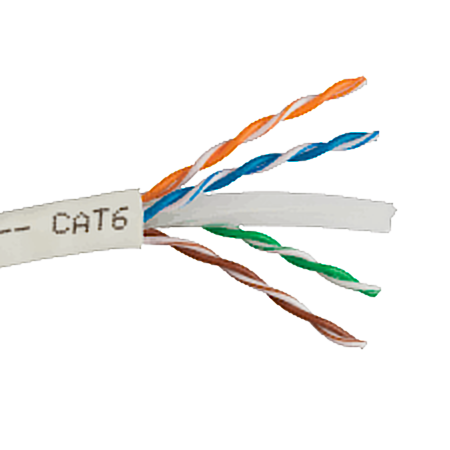Whenever you are setting up a wired network, choosing the right ethernet cable is a priority since the speed and efficiency of the entire network rely on it. Although there are many types of Ethernet cables in the market, the latest standard among them is CAT8. No matter how good the latest standard ethernet cables are, they are costly, and not everyone needs such overpowering cables for their particular work requirements.
That said, the majority of people still prefer using other standards such as a CAT5e or CAT6 cable as they are much affordable and do a decent enough job. Well, both the cables have pretty similar pricing; most people don’t know the actual differences between the two. That’s why we have come up with this article to discuss all the similarities and dissimilarities between CAT5e and CAT6 Ethernet cables to find out which one of them is a better option for you. So, buckle up, and read this article until the end.
Outline
ToggleWhat is CAT5e Cable?
The ‘e’ in the CAT5e stands for the term ‘enhanced’ since it is a successor to the old CAT5 cables and has a few extra perks than the earlier standards. The CAT5e cables are the new default, which comes with almost every networking device you buy these days, such as routers, switches, modem, etc. Among all the ethernet cable standards, the CAT5e cables were the first one to have support for 1Gbps speed, which is a minimum requirement for any network in the current scenario. Speaking of their construction, the CAT5e cables have 24-gauge twisted pair wirings and they operate on 100MHz frequency.
What is CAT6 Cable?
As the technologies keep on improving, the CAT6 standard offers a few additional advantages over the latter and has plenty of improvements in all aspects. The CAT6 cables have a similar 23-gauge twisted pair cable design from the inside. But due to additional shielding, CAT6 cables are generally thicker and have fewer crosstalk issues.
In fact, when it comes to smaller distances, say, up to 180 feet, the CAT6 cables operate extremely fast and are even compatible with 10 Gigabit networks. Moreover, the frequency of the CAT6 cables is almost double that of the previous standards, about 250MHz-500MHz. However, once the distance goes above 180 feet, the transmission speed of CAT6 cables comes down to 1Gbps, just like the CAT5e standards.
Comparison chart of Cat5e and Cat6
| CAT5e Ethernet Cables | CAT6 Ethernet Cables | |
| Pricing | Generally costs $0.20-$0.30 per foot, varies by manufacturer | Around 20% more than CAT5e cables, varies by manufacturer |
| Frequency | 100MHz | 250-500MHz |
| Max Length | 100 Meters Max length | 100 Meters max length, Supports Gigabit networks up to 55 meters. |
| Performance | Performs better than CAT5 | Performs better than CAT5e, less crosstalk, and interference |
| Theoretical Data Transfer Speeds | 1000Mbps | 10Gbps (up to 55 meters) |
| Standard Gauges in Conductors | 24-26 AWG wire | 22-24 AWG wire |
| Connector Type | RJ45 (aka 8P8C) | RJ45 (aka 8P8C) |
Cat5e and Cat6 Differences:
Although both the cables look pretty similar, there are a bunch of factors that make them way different from each other than you think. We are mentioning some of the key factors about both the type of ethernet cables in which they differ so that you can know which one you should be buying for your requirements.
CAT5e vs. CAT6 Bandwidth
Speaking of bandwidth, you get to see 4 twisted pairs of cables in both CAT5e and CAT6 cables. However, the operating frequency of the CAT5e cables is limited to 100MHz, whereas the newer CAT6 cable is designed to operate at a much better frequency, around 250-500MHz. This makes a huge difference in the way they perform as the CAT6 cables generally experience lesser interference, and crosstalk issues during the transmission.
CAT5e vs. CAT6 Speed
Comparing them on the basis of speed, most people believe that both perform way too similarly to each other. Well, it’s a partially correct statement, but there’s a catch! If the network infrastructure is small, say around 33-55 meters, the CAT6 cables can support 10 Gigabit Network speeds and offer up to 10Gbps max speed. On the other hand, if the range extends over 55 meters, both the CAT6 and CAT5e cables perform in an exactly similar manner offering only up to 1 Gbps data transmission rate.
CAT5e vs. CAT6 Crosstalk
Both the CAT5e and CAT6 Ethernet cables are pretty much similar if we look at their construction as both consist of 4 twisted pairs of cables. However, you should know that CAT6 cables have a nylon spline in the wiring, which makes the cable achieve its high bandwidth of 250MHz. Not only it makes the overall cable more strengthful and flexible but also helps in reducing the overall crosstalk and noise. This is typically a major improvement done as compared to the predecessor CAT5e cables.
CAT5e vs. CAT6 Maximum Length
Both the CAT5e and CAT6 cables support a max length of 100 meters, but the way they perform across the length makes them differ from each other. While the CAT5e cables remain consistent all across the length and limited to a 1 Gbps data rate. The CAT6 cable, on the other hand, can support 10 Gigabit network speeds up to the length of 33-55 meters depending on the interference levels, which makes CAT6 cable a great option for small network infrastructures.
Cat5e and Cat6 Similarities:
- Both the CAT6 and CAT5e cables have a maximum support length of 100 meters only.
- At the max length of 100 meters, the speed offered by both CAT6 and CAT5e cables is the same, i.e., 1 Gbps.
- Both the cables come in unshielded (U/UTP) construction for general use and shielded for commercial use where interference is generally experienced more often.
- Both the CAT6 and CAT5e cables have 4 twisted pairs of wiring.
- Both of the cables use the same RJ45 (aka 8P8C) connector.
Conclusion: CAT5e vs. CAT6 Cable
Since we have discussed almost all the differences and also the similarities between the CAT5e and CAT6 cables, which one do you think is a better option to pick? Well, if you ask us, we believe that the CAT6 cables are definitely a good option since it offers an overall better performance than the latter.
While the CAT5e cables are limited to 1 Gbps speeds, you can utilize the CAT6 cables for 10 Gigabit networks as well; conditions apply. The CAT6 cables have much better construction, thanks to the nylon spline that provides flexibility and rigidity. The best part about CAT6 cable is that it’s also backward compatible and will work just fine with devices that only support up to CAT5e cables.
Apart from that, due to the improved bandwidth of 250MHz, interference and noise issues are barely experienced with CAT6 cables. In all, if you get to choose between a CAT5e and CAT6 cable, you know which one of them is a better pick!



